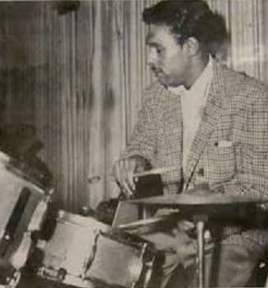Roy Porter was a product of luck, talent, and circumstance. He would go down in history as a pioneer in bebop through his contributions to Charlie Parker’s legendary (and now infamous) recordings for Dial Records, Los Angeles, 1946. Porter was born in a small town and moved to Colorado Springs at age 8 with his mother after his father’s death. There he was raised and attended Wiley College in Texas. Kenny Dorham, the trumpeter, was also one of his classmates. He was influenced by the swing era legends Gene Krupa, Chick Webb and began playing rhythm and blues as a teenager. In 1944, he moved to Los Angeles, playing with Teddy Bunn’s Spirits of Rhythm, and then he joined the modernist quintet of Howard McGhee, which he formed in 1945. Bebop was a new form, and Porter was a passionate convert to it. When Dizzy Gillespie brought in a quintet of New Yorkers to perform at a Hollywood residence, Billy Berg’s club in Hollywood that featured the saxophonist, Porter was able to connect with Charlie Parker. After the return of the trumpeter and his fellow musicians, Parker remained in Los Angeles and started a series recording for the small independent label owned by Ross Russell. Russell also became the biographer of the saxophonist. On the West Coast, there were few genuine bebop drummers. Porter was the obvious choice for the 28 March 1946 session, which produced historic versions of “Ornithology”, “A Night in Tunisia”, and “Moose The Mooche”. Porter was once again the drummer for the second session, which took place on 29 July 1946. Parker was unable to hold his horn and struggled through “Loverman” as well as two other more difficult tunes in the prelude to being admitted to Camarillo State Hospital. Parker returned to New York after his stint with McGhee. Porter worked with McGhee again until 1947 and then with Dexter Gordon and Teddy Edwards, two of the most prominent bebop musicians from the west coast. In the late 40s, Parker was a frequent participant in Los Angeles’s after-hours scene. He also formed a modernist big band in 1948 that included many emerging jazz stars in waiting, including Chet Baker, Art Farmer and Eric Dolphy. The project was ultimately destroyed by the economics of managing such a band. Additionally, the master tapes of some recordings were burned in a fire. This added bitterness to the drummer. For a while, he was a part of the San Francisco jazz scene alongside the likes Hampton Hawes or Sonny Criss. He was prominent in commercial settings with Louis Jordan and Earl Bostic, rhythm and blues musicians, as well as Perez Prado’s Latin band. He spent most of his 1960s in commercial session work, with occasional excursions into pop songwriting. However, he also led a fine jazz group that featured Joe Sample (later to become a star with The Jazz Crusaders) on the piano. Although he retired from performing in 1978 due to health reasons, he continued to give workshops and run a publishing business for a while. His candid autobiography, which charts his life in jazz as well as his heroin addiction, is also available. From www.jazzhouse.org
